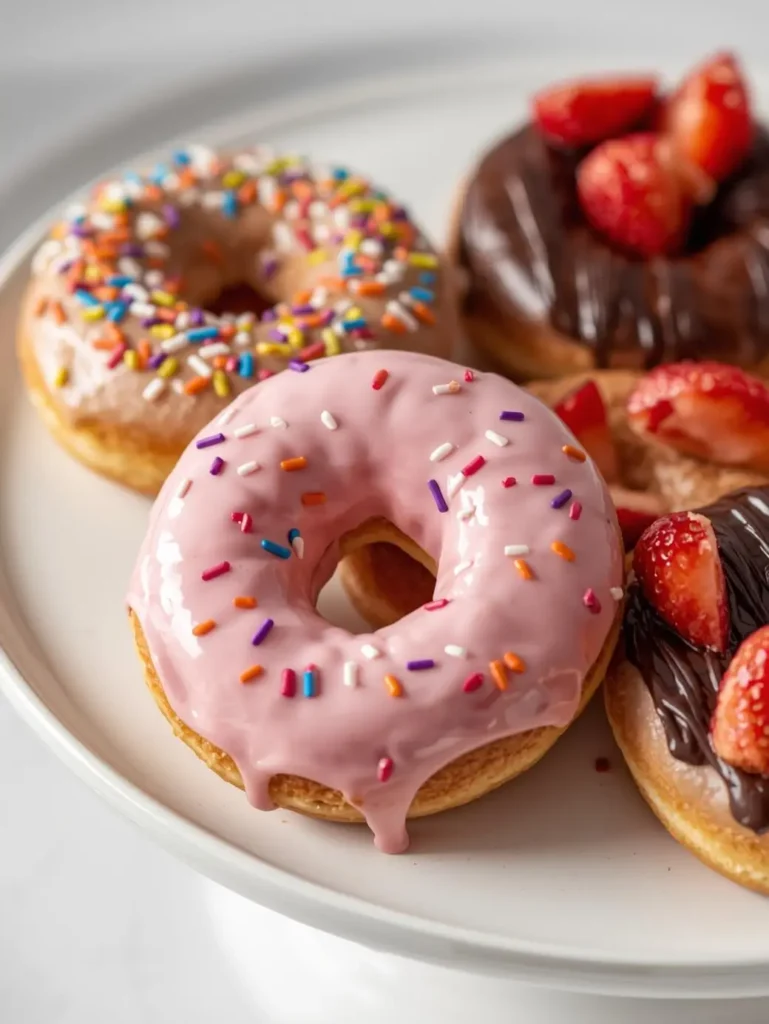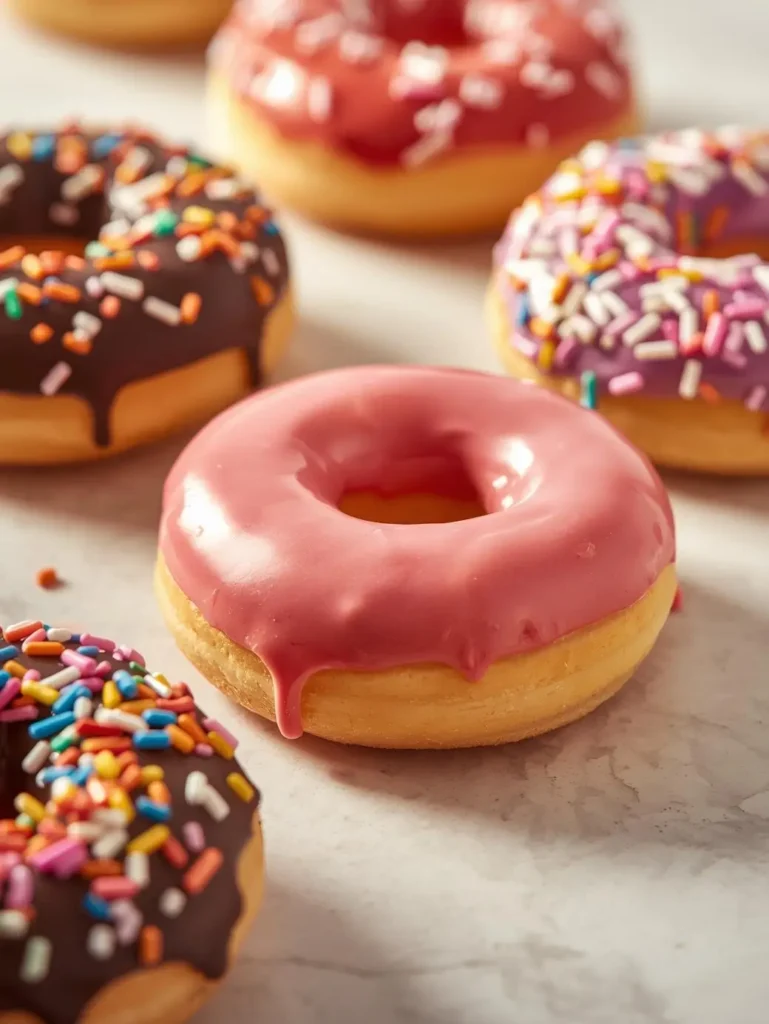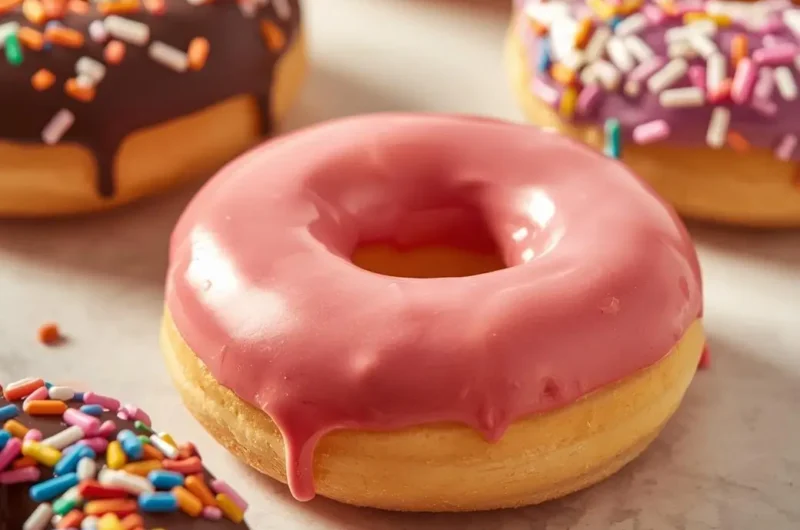Can Gluten Free Donuts Really Rival Their Classic Counterparts?
Jump to RecipeHave you ever wondered if gluten free donuts can truly match the taste and texture of traditional, wheat-based pastries? Surveys show that over 30% of Americans are actively seeking gluten free options, not only for medical reasons but also for wellness and lifestyle choices. Yet, many home bakers find themselves skeptical—will a gluten free donut deliver the soft crumb, delicate sweetness, and satisfying bite that donut lovers crave?
Gluten free donuts have come a long way, harnessing innovative flour blends and naturally gluten free ingredients to create treats that are nearly impossible to distinguish from their conventional counterparts. The best part? You don’t have to compromise on flavor, aroma, or satisfaction. With the right recipe, even the most devoted donut purists are left pleasantly surprised.
Let’s look at the secrets behind achieving crave-worthy gluten free donuts in your own kitchen—demystifying ingredient swaps, timing, structure, and secrets for next-level satisfaction.
- Rustproof Material
- Really strong and heavy duty magnet
- Space saver on the side of our refrigerator for our small kitchen with limited space
- Treat Yourself To A Set Worth Having – With single metal construction and heavy duty premium Stainless Steel, these meas…
- Magnetic For Easy Use And Storage – These magnetic spoons let you use one spoon at a time and then they nest together fo…
- Save Time And Hassle With These Dual Sided Spoons: The oval end is narrow to fit into most spice jars. You won’t need to…
- Outstanding Material:Our bench scraper is made of food-grade stainless steel, ensuring the utmost safety and durability….
- Multi-purpose Dough Cutter:The bench scraper is a perfect gadget for household. The versatile kitchen utensils are not o…
- Olive Shaped Handle:The grip handle conforms to ergonomic standards, providing comfortable, and non-slip grip, allowing …
Ingredients List: Foundations of Gluten Free Donuts
The foundation of the perfect gluten free donut lies in the ingredient selection. Here’s what you’ll need for irresistibly fluffy donuts that are both celiac-friendly and crowd-pleasing:
- Gluten Free Flour Blend (2 cups): Choose a high-quality, all-purpose gluten free flour mix containing rice flour, potato starch, and tapioca flour. Ensure your blend includes xanthan gum or guar gum for the best structure and mouthfeel.
- Baking Powder (2 tsp): Helps achieve a pronounced rise, ensuring lightness.
- Baking Soda (¼ tsp): Adds just enough lift and counteracts dense textures.
- Sea Salt (½ tsp): Enhances all the other flavors.
- Ground Nutmeg (½ tsp) & Cinnamon (½ tsp): Aromatics that echo classic donut-shop flavors.
- Sugar (¾ cup): For sweetness, but coconut sugar works for a richer, caramel note.
- Eggs (2): Essential for structure and moisture. To make vegan, use flax eggs (2 tbsp ground flax mixed with 6 tbsp water).
- Milk (¾ cup): Dairy or unsweetened almond, oat, or coconut milk for a lactose-free batch.
- Unsalted Butter (4 tbsp, melted): Provides richness. Substitute with vegan butter or neutral oil for dairy-free needs.
- Vanilla Extract (2 tsp): Adds depth and a pleasing aroma.
- Apple Cider Vinegar (1 tbsp): Reacts with leaveners for a gentler crumb.
Optional additions: mini chocolate chips, a citrus zest, or even a splash of maple syrup for creative spins.
Ingredient Substitution Table
| Original Ingredient | Substitute(s) | Notes |
|---|---|---|
| All-Purpose GF Flour | Oat flour, almond flour blend | Adjust ratios for texture, add extra binder |
| Eggs | Flax eggs, chia eggs | Makes it vegan, adds subtle nutty flavor |
| Dairy Milk | Almond, soy, oat, or coconut milk | Keeps donuts dairy-free and allergy friendly |
| Butter | Coconut oil, vegan butter | Different fats affect texture |
| Sugar | Coconut sugar, maple syrup, agave | Lower glycemic or deeper flavor profile |
Varying ingredients doesn’t just accommodate dietary needs; it introduces new flavors and textures that can make the recipe uniquely yours.
Timing: Faster, Fresher, More Fulfilling
One recurring challenge with gluten free recipes is complicated steps and extended proofing times. This donut recipe is designed for simplicity and efficiency.
- Preparation Time: 20 minutes
- Cooking/Baking Time: 15-18 minutes
- Total Time: About 40 minutes (that’s 25% faster than standard yeast-raised donuts)
Since this recipe uses baking powder and soda as leaveners rather than yeast, there’s no waiting around for the dough to rise. From mixing bowl to bite, your kitchen will smell like a bakery in less than an hour.

Step-by-Step Instructions
Step 1: Prepare Your Donut Pan
Preheat your oven to 350°F (175°C). Lightly grease your nonstick donut pan with oil or a nonstick spray. This is the key to easy release and golden, crispy bottoms.
Pro tip: Silicone pans make unmolding even easier if you have one available.
Step 2: Measure and Mix Dry Ingredients
In a large mixing bowl, whisk together your gluten free flour blend, baking powder, baking soda, salt, nutmeg, cinnamon, and sugar. Ensuring even distribution at this stage maximizes rise and flavor.
Step 3: Combine Wet Ingredients
In a separate bowl, beat eggs, milk, melted butter, vanilla, and apple cider vinegar until fully emulsified. This ensures a more uniform crumb in the finished donut.
Actionable tip: Ensure wet ingredients are at room temperature so they incorporate seamlessly.
Step 4: Merge and Mix
Pour the wet ingredients into the dry mixture. Gently fold together with a spatula, mixing until just combined. Overmixing can lead to dense or gummy donuts—aim for a cohesive, fluffy batter.
Step 5: Pipe and Bake
Spoon the batter into a piping bag or a resealable plastic bag with one corner cut off. Pipe the batter into the donut pan wells, filling each about three-quarters full. Bake for 15 to 18 minutes, or until the donuts spring back when lightly touched and a toothpick comes out clean.
Step 6: Cool and Finish
Allow donuts to cool in the pan for 5 minutes before transferring to a rack. Finish with a dip in cinnamon sugar, icing, or a simple glaze of your choice. Gluten free donuts can take a bit longer to fully solidify, so resist the urge to remove them immediately.
Nutritional Information
Gluten free donuts, while indulgent, offer a relatively balanced treat when compared to deep-fried options. Here’s how a single baked donut (based on this recipe) typically stacks up:
| Nutrient | Amount per Donut (standard) |
|---|---|
| Calories | 165 |
| Total Fat | 6g |
| Sat. Fat | 2g |
| Carbohydrates | 26g |
| Sugar | 11g |
| Fiber | 2g |
| Protein | 3g |
| Sodium | 135mg |
- Lower fat: Baked, not fried.
- Higher fiber: Using blends that include oat or almond flour.
- Less sugar: Potential for lower glycemic options like coconut sugar.
These insights may vary depending on your ingredient swaps.
Healthier Alternatives for the Recipe
Customizing for personal wellness is simple with these tips:
- Sugar Reduction: Substitute half the sugar for a blend of monk fruit sweetener or stevia.
- Whole Grain Flours: Mix in certified gluten free oat flour or buckwheat flour for nutritional density.
- Nut-Free: Use sunflower seed flour or a rice-based blend for allergen-free needs.
- Higher Fiber: Stir in 2 tablespoons ground chia or flaxseed to boost fiber and omega-3s.
- Lower Fat: Opt for applesauce or Greek yogurt in place of some of the melted butter.
With a few tweaks, gluten free donuts transform from a sweet treat into a more functional, filling snack.
Serving Suggestions
What truly takes a donut from enjoyable to unforgettable is the way it’s served. Warm donuts fresh from the oven are ideal, but they pair beautifully in various settings:
- Classic: Dust donuts with cinnamon sugar or a light vanilla glaze.
- Party-Ready: Create a DIY donut topping bar with dips like dark chocolate, sprinkles, freeze-dried fruit, or coconut flakes.
- Holiday Brunch: Stack donuts on a cake stand alongside fresh berries, compote, or even a drizzle of honey.
- Mini-Donuts: Make bite-sized versions for kids’ snacks or as a festive finger food at gatherings.
- Breakfast Sandwich: Slice a donut and fill with nut butter and sliced banana for a hearty start to the day.
Personalize each batch to suit the crowd and the occasion.
Common Mistakes to Avoid
Every baker encounters a learning curve with gluten free recipes. Here are the typical pitfalls and how to sidestep them:
- Overmixing Batter: This can lead to dense, chewy donuts. Mix only until just combined.
- Skipping Binders: High-quality gluten free flour blends provide structure. Omitting xanthan gum or eggs makes donuts prone to crumbling.
- Overbaking: Gluten free donuts dry out quickly. Stick to the lower end of recommended bake times and test for doneness early.
- Using the Wrong Flour Mix: Not all gluten free blends behave the same. A mix with a starch, rice flour, and a gum offers the best texture.
- Removing from Pan Prematurely: Let donuts rest for 5-10 minutes to set before unmolding to avoid breakage.
Avoiding these issues leads to bakery-quality donuts every time.
Storing Tips for the Recipe
To keep your gluten free donuts soft and flavorful:
- At Room Temperature: Store in an airtight container for up to 2 days.
- Freeze for Later: Wrap individually in plastic wrap, place in a freezer-safe bag, and freeze for up to 2 months. Thaw at room temperature or microwave in 10-second bursts.
- Reheat Safely: Warm donuts in a 300°F oven for 3-5 minutes to revive the bakery-fresh texture.
If you plan to store for more than a day, consider leaving glazes or toppings off until ready to serve, ensuring maximum freshness and crunch.
Summary and Invitation
Gluten free donuts prove that dietary restrictions don’t have to limit indulgence. With the right blend of flours, careful mixing, and creative toppings, you get a donut that delights both gluten free eaters and donut aficionados alike. Try this recipe at home, share your creations in the comment section, and subscribe for more delicious updates and tips. Your feedback and photos always inspire.
FAQs
What gluten free flour blend works best for donuts?
Choose a blend with rice flour, potato starch, and a touch of xanthan gum. Brands like Bob’s Red Mill 1-to-1 or King Arthur measure-for-measure often yield the best, fluffiest results.
Can I fry this recipe instead of baking?
Yes, simply use a thick piping bag to shape doughnuts and fry in hot oil at 350°F until deeply golden, about 3 minutes per side. Baking is healthier, but frying creates a classic exterior crunch.
How can I tell when gluten free donuts are done baking?
The tops should spring back lightly when touched and a toothpick inserted comes out clean, with no wet batter clinging. They continue to firm up as they cool.
Are gluten free donuts safe for people with celiac disease?
As long as every ingredient is certified gluten free and cross-contamination is avoided in your kitchen, these donuts are a safe option for people with celiac or gluten sensitivity.
Why do my gluten free donuts come out dense or gummy?
This is often due to overmixing, using too much liquid, or skipping a binder. Follow the recommended amounts and handle the batter minimally for a light, cake-like texture.
Ready to make gluten free donuts your new favorite treat? Let’s see your sweet success stories in the comments!
Gluten Free Donuts: Experience Pure Delight Today
Course: gluten free4
servings20
minutes18
minutes165
kcal40
minutesIngredients
Gluten Free Flour Blend (2 cups): Choose a high-quality, all-purpose gluten free flour mix containing rice flour, potato starch, and tapioca flour. Ensure your blend includes xanthan gum or guar gum for the best structure and mouthfeel.
Baking Powder (2 tsp): Helps achieve a pronounced rise, ensuring lightness.
Baking Soda (¼ tsp): Adds just enough lift and counteracts dense textures.
Sea Salt (½ tsp): Enhances all the other flavors.
Ground Nutmeg (½ tsp) & Cinnamon (½ tsp): Aromatics that echo classic donut-shop flavors.
Sugar (¾ cup): For sweetness, but coconut sugar works for a richer, caramel note.
Eggs (2): Essential for structure and moisture. To make vegan, use flax eggs (2 tbsp ground flax mixed with 6 tbsp water).
Milk (¾ cup): Dairy or unsweetened almond, oat, or coconut milk for a lactose-free batch.
Unsalted Butter (4 tbsp, melted): Provides richness. Substitute with vegan butter or neutral oil for dairy-free needs.
Vanilla Extract (2 tsp): Adds depth and a pleasing aroma.
Apple Cider Vinegar (1 tbsp): Reacts with leaveners for a gentler crumb.
Directions
- Prepare Your Donut Pan
Preheat your oven to 350°F (175°C). Lightly grease your nonstick donut pan with oil or a nonstick spray. This is the key to easy release and golden, crispy bottoms.
Pro tip: Silicone pans make unmolding even easier if you have one available. - Measure and Mix Dry Ingredients
In a large mixing bowl, whisk together your gluten free flour blend, baking powder, baking soda, salt, nutmeg, cinnamon, and sugar. Ensuring even distribution at this stage maximizes rise and flavor. - Combine Wet Ingredients
In a separate bowl, beat eggs, milk, melted butter, vanilla, and apple cider vinegar until fully emulsified. This ensures a more uniform crumb in the finished donut.
Actionable tip: Ensure wet ingredients are at room temperature so they incorporate seamlessly. - Merge and Mix
Pour the wet ingredients into the dry mixture. Gently fold together with a spatula, mixing until just combined. Overmixing can lead to dense or gummy donuts—aim for a cohesive, fluffy batter. - Pipe and Bake
Spoon the batter into a piping bag or a resealable plastic bag with one corner cut off. Pipe the batter into the donut pan wells, filling each about three-quarters full. Bake for 15 to 18 minutes, or until the donuts spring back when lightly touched and a toothpick comes out clean. - Cool and Finish
Allow donuts to cool in the pan for 5 minutes before transferring to a rack. Finish with a dip in cinnamon sugar, icing, or a simple glaze of your choice. Gluten free donuts can take a bit longer to fully solidify, so resist the urge to remove them immediately.






